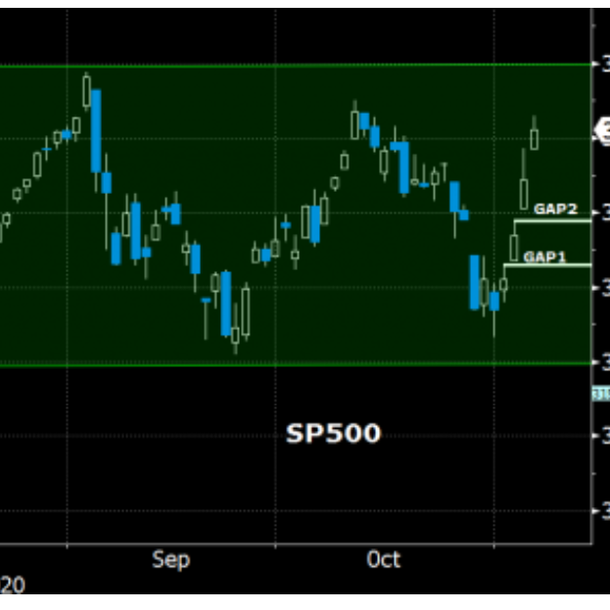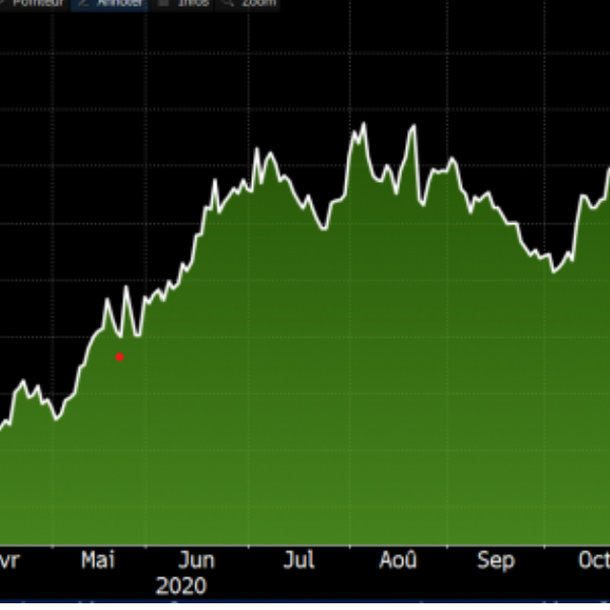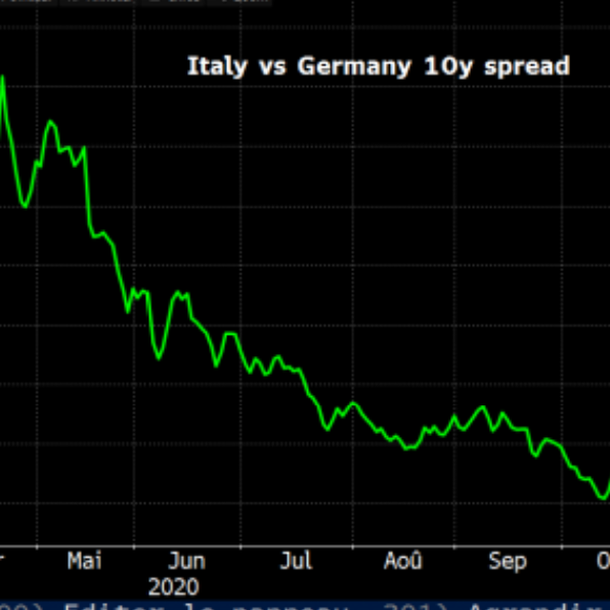|
Monday November 9 | Weekly market update |
 | Temporarily relegating health fears to the background, stock markets rebounded violently today and last week as traders focused their attention on the US presidential election. Joe Biden has won the race for the White House, which has clearly contributed to rekindle the appetite for risk. In spite of some profit-taking last Friday, the balance sheet is particularly positive, Europe recording its strongest weekly progression since the beginning of June while Wall Street realizes its best presidential week in 50 years. |
| Indexes Today, most markets soared. Over last week, all financial markets have progressed. In Asia, the Nikkei gained 5.9%, returning to levels not seen since 1991. The Hang Seng gained 6.7% and the Shanghai Composite 2.7%. In Europe, the CAC40 recorded a weekly performance of 7.8%, the Dax gained 7.9% and the Footsie 5.8%. For the peripheral countries of the euro zone, Italy won 9.3%, Spain 6.4% and Portugal 2.5%. In the United States, the Dow Jones was up 6.9%, the S&P500 was up 7.1%, thus returning to a little more than 2% of its historical record (see graph). As for the Nasdaq100, it advanced by 8.8%. Stabilisation of the S&P500, with a final dynamic thrust (2 gaps)  |
| Commodities Oil prices advanced significantly last week, buoyed by hopes of OPEC+ mobilization to support prices. The cartel, backed by Russia, could postpone its production increase, initially planned for early next year. Brent is hovering around USD 40 per barrel while WTI is trading at USD 38.2. Precious metals are on a roll and are performing well on a weekly basis. Helped by the weakness of the US dollar, gold crossed the USD 1900 mark and is now trading around USD 1950. Silver imitates this course by returning above USD 25. The industrial metals segment, whose components all recorded gains last week, had a solid performance. Aluminum jumped to $1885, copper advanced to $6800, zinc traded at a year high of $2,600 while tin gained 4.1% to $18,375. |
| Equities markets Pinduoduo operates an exclusively mobile e-commerce application in China. A bit like Alibaba or Amazon except that there is no website. The concept is to offer Chinese consumers the possibility to make group purchases via a "team purchase" either with friends, family or even strangers in order to reduce the total price of the transaction. To do so, Pinduoduo has created an Asian-specific environment with in-app games to win promotions and encourage interaction with other players to perhaps? create a team purchase. Simply put, Pinduoduo wants to be the next generation of e-commerce. But what does that mean in numbers? In the last quarter, the group has 683.2 million active customers who make an average annual basket of 1,857 renminbi, or 280.5 dollars. 89% of Pinduoduo's turnover comes from online marketing services (advertising, sales options, etc.) and 11% from transaction commissions. In 2017, this represented the equivalent of 263.5 million dollars. In the space of two years, sales have multiplied by 17 and analysts covering the value (27 in total) expect an average revenue of 14.8 billion dollars by 2022, which would represent an evolution of more than 5000% on the basis of 2017. On the other hand, Pinduoduo is not expected to be profitable before 2021 according to the analysts' consensus. Indeed, the group still has high sales and marketing costs, evolving between 70% and 110% of turnover depending on the quarter to give visibility to its mobile platform. Nevertheless, in 2019, the company was based on a free cash flow of 2.23 billion dollars. These fundamentals are reflected in a stock market plan. Pinduoduo achieved an unrealized performance of 191.5% over 2020 and reached a market capitalization of $132 billion. Pinduoduo  |
| Bond market The bond market sentiment is characterized by easing, like the US 10-year yield which loses 12 basis points to 0.76%. Investors once again rushed to government bonds as hopes of recovery faded and uncertainty about the outcome of the presidential race pushed them to take refuge last week. The speakers also expressed a desire to buy European bonds. The Bund is trading with a rate of -0.64%, while the French OAT fell again to -0.37%. The countries of Southern Europe are benefiting from this craze for sovereign securities. Italy sees its 10-year benchmark fall to 0.64%, while Portugal and Spain will soon have negative-rate debt (0.07%). As for Athens, the Greek government is pleased to note that its major loan is paying interest at an all-time low of 0.81%. Fearing currency fluctuations to a lesser extent, operators are less inclined to arbitrate in favor of the Swiss debt and the robustness of its franc. The yield over 10 years therefore remains stable at -0.57%. Gradual narrowing of the spread between the German Bund and the Italian 10-year maturity  |
| Forex market Last week, the greenback fell against all major currencies. The EUR/USD pair took advantage of arbitrage arbitrage by forex traders to form an acceleration in favor of the single currency to USD 1.186. Across the channel, the Bank of England boosted its bond purchase program by 150 billion pounds, more than expected, as part of a stimulus package to help the economy. The BOE, which now expects the economy to contract this quarter, has eased monetary policy four times since March, flooding the economy with liquidity to keep borrowing costs down. The pound is logically being affected by these monetary adjustments to trade below 1.30 against the dollar. The safe-haven currencies are logically retreating in a climate of risk-taking on the markets. The yen fell 150 basis points against the single currency to JPY 122.5. Also in Asia, the USD/CNY fell to new lows (CNY 6.62) and the victory of the Democrat Joe Biden could prolong this movement. |
| Economic data In China, the PMI manufacturing and services indices (Caixin) both exceeded expectations, at 53.6 and 56.8 respectively (against 52.9 and 55.1 expected). In the euro zone, these same indices also beat the consensus, with a manufacturing index at 54.8 (54.4 expected) and a services index at 46.9 (46.2 consensus). The PPI index was in line with expectations at +0.3% but retail sales declined more than expected (-2% vs. 1.4% expected and +4.2% last month). In the United States, in addition to the contrasting employment data, the statistics were generally reassuring. The ISM manufacturing and services indices came out at 59.3 and 56.9 respectively. Industrial orders rose by 1.1% but construction spending by only 0.3% (consensus 1%). In terms of employment, the ADP reported only 365K jobs created (650K expected) and weekly unemployment registrations rose to 751K. The unemployment rate stood at 6.9%, with 638K jobs created (consensus 595K) and an hourly wage up 0.1%. |
| Investors see life in blue The nail-biting U.S. election has not frightened markets, quite the contrary. Investors, who were largely cautious before the political deadline, massively unwound their hedging positions, thus generating a flow of massive redemptions on the various indices. Graphical extensions surprised all the specialists. The expected blue wave, which has become light blue, is more satisfying because it should result in budgetary, fiscal and regulatory policies favorable to large companies. In the short term, this prospect therefore outweighs all uncertainties. |

 By
By 










